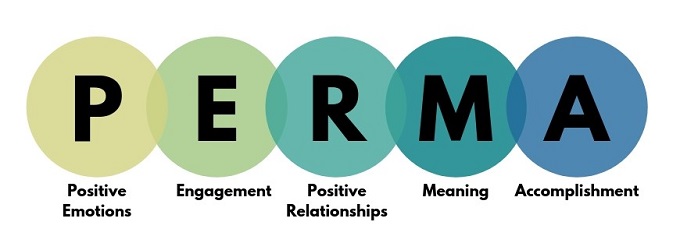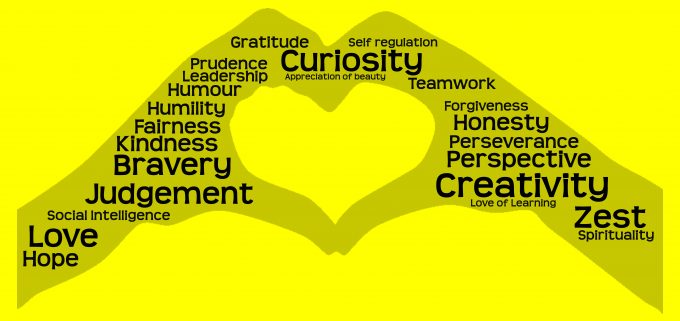Wellbeing: What’s it about?

Wellbeing has permeated every facet of our social psyche. It’s in vogue, a fashionable word, possibly even overused.
A bit like resilience, but that’s a word for another day.
It’s even made CORE’s Ten Trends this year. Wellbeing is defined by the Oxford English Dictionary as “The state of being comfortable, healthy, or happy.” Internationally there is no agreement on a definition for wellbeing, however, those who research the area agree that wellbeing is more than the absence of disease, it is a construct with many parts. In order to flourish, people need to experience high levels of wellbeing.
Positive Psychology is the field of science that explores optimal human functioning and aims to discover the factors that enable individuals and communities to thrive. Where traditional psychology explores what’s wrong with us and is very much focused on a disease model, Positive Psychology asks what is right with us. This science is also about the permission to be human and being able to experience the full range of human experiences and emotions without getting stuck or hiding from emotions that are hard. As humans, we can become mentally unhealthy when we get stuck in anger, anxiety, depression, judgement or guilt. Positive Psychology offers us tools for coping with negative events, enhancing positive experiences and flexibly moving through the whole gamut of human emotions as we journey through life. It is this lens that I write with.
Focusing on the adults first
It makes sense that if we look after our teachers that they are going to look after our ākonga. I like psychology professor Felicia Huppert’s description of wellbeing: Feeling good and functioning well. So for the purposes of this post, this is the definition we will keep in mind
To operate at our best we need to be well. We all have personal stories about people who, by their own admission, contributed to the outcomes of challenging and difficult situations because they were not operating at or even near their full potential. I’ll never forget the highly stressed doctor (her very own words, and she looked it) repeatedly failing to insert a needle that would drip feed essential medication to our fragile premature son’s heart. Thankfully a mindful nurse intervened, took over and got the vein on her first attempt. We intuitively know it, and the evidence backs it up, when an organisation or individual’s wellbeing is high, performance is enhanced, people are happier, healthier and more connected.
As a profession here in New Zealand, educators are a generous bunch. At times it appears that working hard in education is like a badge of honour. How can you really care when you don’t put your life and soul into the vocation. Give, give, give until we’re spent! Let’s be realistic, this is not sustainable, certainly not if we expect the best outcomes for our ākonga. We instinctively know this is right. How could it not be true? Yet the conveyor belt that is modern life, and our education system, continues to rattle around at an ever faster pace.
We need to be mindful that giving everything for others and leaving nothing in the tank for ourselves can leave us utterly depleted. Again sustainability is the issue here, particularly given the critical teacher shortage that we are currently experiencing in Aotearoa, New Zealand.
We need to be more mindful about our lives, including our workspaces. We need to make the connection that our wellbeing impacts on our ability to be great at what we do. We need to tune in. We need to make wellbeing a part of daily routines.
Just one small step
We often talk about the idea of micro-steps when working with teachers around their wellbeing. There is a variety of wellbeing frameworks out there. However, one of the most widely used wellbeing frameworks referred to as PERMA, comes from the work of Professor Martin Seligman.
Seligman believes there are five foundational pillars to wellbeing:
- Positive emotions (some describe this as happiness)
- Engagement
- Relationships
- Meaning and purpose
- Accomplishment.

Graphic by Lauren Douglas, CORE Education. CC BY-NC-ND 4.0
Want to measure your own wellbeing?
Your responses to the 23 questions on the PERMA meter will give you an idea of how well you are doing in relation to the five pillars. Other researchers have since added an additional pillar of vitality or health which refers to our sleeping, eating, physical movement and our ability to cope with stress. I like the PERMAH (where the H stands for Health) survey created by McQuaid and Kern, leading researchers in the applications of positive interventions.
When considering being well from a Te Ao Māori stance, one of our well-known wellbeing frameworks is Te Whare Tapa Whā, developed by Professor Sir Mason Durie ,1995).
Te Whare Tapa Whā has four foundational walls:
Te Taha Hinengaro (psychological health)
Te Taha Wairua (spiritual health)
Te Taha Tinana (physical health)
Te Whānau (family health)

Image by gerard on Flickr. CC BY-SA 2.0.
We also have Te Wheke, which was developed by Dr Rangimarie Turuki Arikirangi Rose Pere. This model provides the additional dimensions of Mauri (life force in people and objects), Hā a koro mā, a kui mā (breath of life from forbearers), Mana ake (unique identity) Whatumanawa (the open and healthy expression of emotion).
The Fonofale model created by Fuimaono Karl Pulottu-Enderman considers the Pacific view on health. Here the idea of cultural values and beliefs as being the shelter of life are expressed.

Image by Michael Coghlan on Flickr. CC BY-SA 2.0.
All these frameworks have much in common. Our head health, body health, our relationships, and meaning and purpose matters to our overall state of being well. Which framework you decide to use, and there are more than I have mentioned here, depends on your own needs in aligning with culture and or personal preference.
Formulating your wellbeing plan
There are a number of positive interventions that we can use to dial up our pillars of wellbeing.
If I had used Martin Seligman’s PERMA framework and completed the survey, a helpful next step for me to consider might be to focus on two of the pillars to keep it manageable. For argument’s sake, let’s say I chose the positive emotion and engagement pillars as my foci.
Positive emotion – To boost this pillar, I may want to engage in the jolts of joy activity. Here I would write down five things that bring a smile to my face and then reach for this list when I need a boost of positivity (such as after an excruciatingly long meeting).
Engagement – Create my play history – remember a time during my childhood where I did something that brought me great joy and excitement, and then think about ways I could recreate this in my work.
Other examples of activities can be found within the PERMAH survey.
When we talk about positive interventions, they are usually simple in nature and often have us referring back to something in our past, present or future. Very doable indeed.
Wellbeing as a collective endeavour
‘Wellbeing’ is very subjective and means different things to different individuals, so a nice place to start is to have a collective understanding of what wellbeing can mean for all those who have a role in supporting our ākonga and then growing your shared understanding from there.
If Positive Psychology were to be distilled into three words it would be that “other people matter”. These are not my words, but those of the late Professor Chris Peterson.
We know from the research that if we wish to impact the wellbeing of our ākonga, we must first impact the wellbeing of our educators. This is not just our teachers, but also any other adult who works directly or indirectly with our ākonga.
Embracing wellbeing: a few compelling reasons
- We often mirror our teaching counterparts in the UK. In the 12 months leading up to April 2018, the Guardianreported that the number of teachers seeking mental health support had risen by 35% from a charity that specialises in supporting teachers in education.
- A 2016 NZ teacher survey discovered that around 87% of teachers (mainly primary) used no strategies to respond to stress and just carried on regardless.
Strategies that enable staff wellbeing
Some effective strategies and practices include:
- Regular conversations about wellbeing with staff
- Leaders being approachable and open to discuss issues around workload and how to collectively manage this
- Flexible spaces and places to work from when on release
- Wellbeing as a regular agenda item on meetings
- Individual/group coaching to support the wellbeing of teachers and leaders
- Having a well-being team that is able to support a planned approach.
In a recent article from one principal who prioritised the wellbeing of their own staff found that they were able to positively impact stress levels and feelings of working in a much more supported environment. Ākonga achievement was also positively impacted.
As nation builders, I believe that our profession is a splendid torch and we want to make it burn as brightly as possible for our future generations. It is imperative that we can do this with our wellbeing intact. We all deserve to feel good and function well.
By being able to focus on wellbeing we are able to build on our emotional resources so that when we are faced with challenging times, either individually or collectively, we can draw on these bank of resources to support us through.
Find out more
- Explore the Educators’ Wellbeing Toolkit
- Talk to your PLD facilitators about how you can weave in wellbeing into your context when considering growing your leaders, staff wellbeing, inclusive practices.
- Chat to Ara about wellbeing facilitation and the next steps in your own learning.








This article was really fascinating. I really appreciate reading very “do-able” easy to implement ideas to -re-centre ourselves as teachers to over come stress in our workplace.
I wondered if there was any research about teachers supporting each other through the stress of the job?
When I read 87% of teachers who were mainly primary experienced stress in 2016 – I know I was one of those. I didn’t realise that it wasn’t only me… that lots of other teachers were experiencing this too. That in a way was rather comforting.